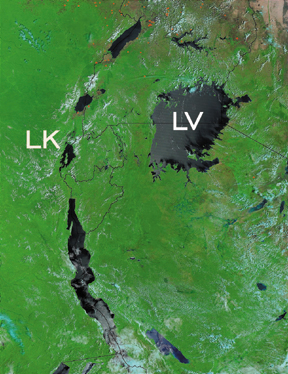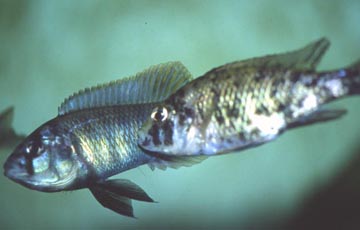Geotimes

Web
Extra Friday,
April 25
Debating the fastest evolution
on record
More than 500 species of brightly colored fish called cichlids live in east
Africa's Lake Victoria. Most of these fish cannot be found in any other lakes
in the world. They have evolved a dizzying variety of roles: insect eaters,
leaf choppers, snail crushers and scale scrapers, to name a few.
 In 1996, geologist
Tom Johnson from the University of Minnesota, Duluth, and colleagues reported
in Science that Lake Victoria and its satellite lakes dried out completely
during the late Pleistocene, about 12,400 years ago. They concluded that the
vast array of cichlids must have evolved from a few ancestors in the time since
the desiccation -- making cichlid evolution the fastest on record for any vertebrate,
by many fold.
In 1996, geologist
Tom Johnson from the University of Minnesota, Duluth, and colleagues reported
in Science that Lake Victoria and its satellite lakes dried out completely
during the late Pleistocene, about 12,400 years ago. They concluded that the
vast array of cichlids must have evolved from a few ancestors in the time since
the desiccation -- making cichlid evolution the fastest on record for any vertebrate,
by many fold.
A paper in the April 11 Science puts the brakes on this rate of evolution.
Evidence locked in the DNA of Lake Victoria's cichlids indicates that the first
burst of speciation began 100,000 years ago, and that the fish have been evolving
since. And, the authors say, the original set of founding species may have itself
been diverse, kick-starting the evolutionary radiation that followed.
"If you start out 10 times longer ago, with fish that were already diversified,
the [cichlid radiation] is easier to imagine," says lead author Erik Verheyen,
an evolutionary biologist at the Royal Belgian Institute of Natural Sciences
in Brussels.
According to the April Science
study, cichlids from Lake Kivu (marked LK) colonized Lake Victoria (LV), setting
the stage for the rapid evolution of over 500 endemic cichlid species. No waterways
currently connect the two lakes, although the authors suspect that ancient rivers
did. Photo courtesy of NASA.
The study presents a new example of how geology and evolutionary biology can
lead to different conclusions. "The contrast between geophysical and molecular
evidence is absolutely fascinating," Johnson says.
The geologic perspective
Lake Victoria sits between two branches of the major rift that runs through
east Africa. Approximately 400,000 years ago, the eastern flank of the western
branch lifted up, causing rivers that had been flowing east to west to reverse
direction. Water ponded, forming the lake.
In 1995, Johnson's team surveyed Lake Victoria's sediments in the hopes of finding
a continuous record of changes in regional climate since the lake formed. They
used seismic profiling to look for sediments with fairly uniform reflectivity
down many tens of meters. Such a profile would indicate that the sediments accumulated
gradually at the bottom of the lake, without any interruption. But the actual
profiles revealed a jump in reflectivity about seven meters beneath the sediment
surface. The team's seismic tracks crisscrossed the lake, always with the same
result.
Piston cores that grabbed segments of this highly reflective layer allowed
for a closer look. The segments crumbled easily, were much thicker than the
sediments above, and were filled with vertical roots and pollen grains from
cattails -- all signs that the sediment formed beneath air, not water, and that
the lake was at one time not a lake, but a vast marsh, Johnson says. Carbon
dating pinned the age of the ancient marsh to approximately 12,400 years old.
While the seismic surveys and piston cores did not extensively sample the whole
lake, the basin bottom is so flat that the entire lake must have dried out when
the water level dropped, the authors argued in the 1996 Science paper.
They concluded that cichlids would not have been able to find any large or deep
refuge in which to wait out the dry spell; few would have survived.
Previous phylogenetic studies had indicated that all of Lake Victoria's cichlids
evolved from a single ancestor. Only one possibility remained, Johnson says:
most of the 500 species found in the lake today evolved in the past 12,400 years.
The molecular perspective
In 2000, Sandra Nagl, a molecular biologist from the Max-Planck Institute for
Biology in Germany, presented a different view, based on DNA sequences from
Lake Victoria cichlids. Fish that belong to the same species tend to have similar
DNA, especially in stretches sitting in what is called the mitochondrial control
region. When one species evolves into two, random mutations in the DNA slowly
cause the control regions of the two new species to diverge from one another.
The greater the divergence, the longer ago the two species split. From such
molecular data, Nagl concluded that the Lake Victoria cichlids began to evolve
100,000 to 200,000 years ago, not 12,400.
 At the
heart of these calculations is what is known as a molecular clock: an estimate
of the amount of time that elapses before a single difference in the DNA code
between two species emerges. Nagl's group assumed a ticking rate of about a
5.6 percent divergence in DNA sequence every million years.
At the
heart of these calculations is what is known as a molecular clock: an estimate
of the amount of time that elapses before a single difference in the DNA code
between two species emerges. Nagl's group assumed a ticking rate of about a
5.6 percent divergence in DNA sequence every million years.
The authors of the April Science article made their own molecular clock
calculations, coming to the same conclusion that the Lake Victoria cichlids
began evolving about 100,000 years ago.
The cichlid Haplochromine paucidens
lives in Lake Kivu and feeds on insects. Photo courtesy of Royal Museum for
Central Africa-Tervuren
The study also finds another factor that slows the rate of evolution, Verheyen
says: the species that began the Lake Victoria radiation were themselves quite
diverse, limiting the degree of speciation needed to happen afterward to explain
today's diversity. From the DNA data, the authors constructed lineages showing
the relationships between the cichlids in Lake Victoria and surrounding lakes.
They discovered that two genetically distinct classes of fish from nearby Lake
Kivu colonized Lake Victoria. Until now, many evolutionary biologists believed
that Lake Victoria's cichlids evolved from a single species. It is not clear
how much diversity -- in terms of size, shape, color and behavior -- the initial
two classes of cichlids encompassed, although it may have been great, Verheyen
says. Today, just one of those genetic classes includes cichlids that graze
on algae, others that eat insects, and still others that eat fish.
Bridging the two?
The two perspectives may have common ground. Even a few lingering ponds in
a mostly desiccated lake could have provided strongholds for cichlids that hunkered
down until the rains came, Verheyen says. That scenario is possible, Johnson
acknowledges: "There was no big deep water lake there. At best there could
have been a cattails swamp with a few ponds."
On the flip side, the DNA-based lineages indicate that several genetically
distinct groups of fish that appear not to live in the lake now must have, at
one point, existed. Perhaps the dessication eliminated these species, the authors
say.
Johnson, however, argues that the molecular clock used to date the cichlid
evolution could be flawed. Robert Schelly, a graduate student at Columbia University
who is studying cichlid evolution for his dissertation, agrees. "You have
variation in the rates of molecular evolution among different loci and different
species," he says. The molecular clock applied to Lake Victoria, he notes,
was calibrated using a different set of cichlid species living in nearby lakes.
Even if the new Science study turns out to be correct, the rate of cichlid
evolution is still astonishing, says co-author Axel Meyer, an evolutionary biologist
at the University of Konstanz, Germany. Whether it is 12,400 years or 100,000
years, cichlids will still hold the record for the fastest known evolution of
vertebrates.
Greg Peterson
Links:
IDEAL
Highlights earth science research done through the International Decade of the
East African Lakes program.
Overview
of the geology and geography of the Great Rift Valley.
Molecular
laboratory, Royal Belgian Institute of Natural Sciences.
 In 1996, geologist
Tom Johnson from the University of Minnesota, Duluth, and colleagues reported
in Science that Lake Victoria and its satellite lakes dried out completely
during the late Pleistocene, about 12,400 years ago. They concluded that the
vast array of cichlids must have evolved from a few ancestors in the time since
the desiccation -- making cichlid evolution the fastest on record for any vertebrate,
by many fold.
In 1996, geologist
Tom Johnson from the University of Minnesota, Duluth, and colleagues reported
in Science that Lake Victoria and its satellite lakes dried out completely
during the late Pleistocene, about 12,400 years ago. They concluded that the
vast array of cichlids must have evolved from a few ancestors in the time since
the desiccation -- making cichlid evolution the fastest on record for any vertebrate,
by many fold. 
 At the
heart of these calculations is what is known as a molecular clock: an estimate
of the amount of time that elapses before a single difference in the DNA code
between two species emerges. Nagl's group assumed a ticking rate of about a
5.6 percent divergence in DNA sequence every million years.
At the
heart of these calculations is what is known as a molecular clock: an estimate
of the amount of time that elapses before a single difference in the DNA code
between two species emerges. Nagl's group assumed a ticking rate of about a
5.6 percent divergence in DNA sequence every million years.